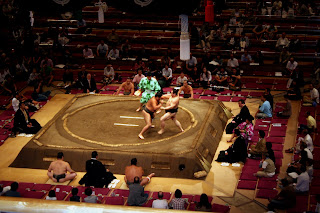Tuesday 23rd September was a national holiday, so Amy and I decided to do some sightseeing. The original plan was to visit Nikko, which is about 1 ½ to 2 hours north of Sugito by train. We agreed to get up very early to make the most of the day, we would be catching the train from Wado station at 7.00am.
7.00am came and went, and I was still in bed! Amy was wide awake and somewhat bemused at my morning of laziness. I dragged myself out of bed at 7.30am but we had missed our train. After breakfast we decided to go with plan B, if only we had one! We quickly decided to just head into Tokyo and see what mischief we could get up to.


The day started out as per the plan with some sightseeing in Tokyo, we started with a visit to the Edo-Tokyo open air architectural museum. The building itself is hideous, it looks like a concrete oil rig (see photo), but inside is really cool. After buying your ticket (a very reasonable 600 yen!), you take the elevator up to the sixth floor which is one of two ‘permanent exhibit areas’. What greets you is a full size replica of the northern half of the original Nihonbashi (Literally – Japan Bridge), as you walk over the bridge you can look down to a number of full size replica buildings on the fifth floor. At the other side of the bridge you come across some large scale models of various parts of Tokyo. The details are very good; I liked the contrast between a Lord’s villa and an area of equal size which housed 1000 common folk.
We headed down to the fifth floor which continues from the Edo-period right through the industrial revolution, the great Kanto earthquake and of course, World War 2. There are lots of other exhibits worth seeing and there are lots of ‘hands-on’ things for children (or adults!) but I won’t spoil them for you, I would definitely recommend the museum.

After the museum, we decided to go for a bit of a walk whilst we decided where to head next. We hadn’t walked very far when we started to get passed by a number of Sumo guys in full kimono. We walked a little further and realised that we were in the centre of ‘Sumo-town’ and the Edo-Tokyo museum is right next door to the National Sumo Arena (Ryogoku Kokugikan). There was nothing else for it, we quickly bought tickets and headed inside.
I sort of followed what was going on, with the help of our English handbook. Most of the bouts were the same; two guys would get up, bow to each other, throw chalk around and wrestle. The winner is the one who makes the other guy fall or touch the floor with anything other than his feet, or move / get pushed out of the roped off ring.

In between each division, all the competitors would have a ceremonial entrance. They all walk in and form a circle in the ring looking towards the crowd, then they all turn 180 degrees lift their hands, do a bit of a clap and then walk off again.

Some of the fights were really good, especially as the day wore on. The most enjoyable bout for me was between a huge guy that was three times the size of his opponent. It looked like the little guy was going to get squashed. When the fight started, the little guy shifted to the left as the big guy attacked. The little guy then simply unbalanced his larger opponent and the big guy crashed on his back to the floor. The crowd went wild! There were other good fights but that was the highlight for me.

Today turned out to be day number 10 of this particular tournament and like all sumo tournaments, it lasts all day. We got there for about lunch time so we watched from the middle of the Jonokuchi (lowest rank) – Makushita (junior grade) category. Next came the Juryo (intermediate) and then the Makuuchi (senior division) event. The tournament finished with the yumitori-shiki or bow dance ceremony.
Here's Asashoru up against Ama on day 9 of the tournament
I really enjoyed watching the sumo live, it feels very different from watching it on TV. The crowd really get into it and you can’t help but get sucked in and you really enjoy yourself. I was particularly surprised at the skill of the wrestlers, they actually use techniques! I never saw the fascination with sumo but I think I’m now hooked, and we're already planning our next trip.












